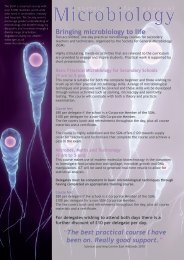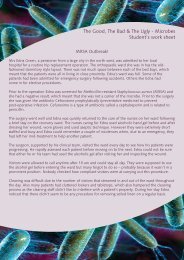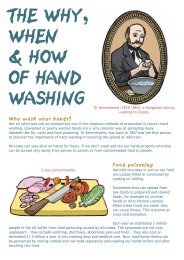Safety guidelines PDF - Microbiology Online
Safety guidelines PDF - Microbiology Online
Safety guidelines PDF - Microbiology Online
Create successful ePaper yourself
Turn your PDF publications into a flip-book with our unique Google optimized e-Paper software.
Appendix 1<strong>Safety</strong> <strong>guidelines</strong>These notes are an updated version of the section on microbiology and biotechnology in <strong>Safety</strong> in Science Education(DfEE, 1996) produced as a result of a safety conference of experts (including MISAC representatives) convened bythe ASE in 1997. They form Chapter 15 of Topics in <strong>Safety</strong> (3rd Edition, ASE, 2001) and are published withpermission.General safety considerationsThe nature of the growth, reproductive capacity and biochemistry of many micro-organisms makes them of greateconomic, social and medical importance. The fundamental rules of personal, public and domestic hygiene rely on anunderstanding of the characteristics of these organisms. Micro-organisms possess many obliging features that makethem ideal subjects for safe practical exercises in schools. Unlike many organisms, they do not necessarily have to bemaintained over long periods and do not have to be fed and watered at weekends! Staff in schools and colleges shouldbe in no doubt of the considerable educational value of thoughtful, practical microbiological work and of the need forevery pupil to possess a basic knowledge of the biology of these organisms.Work in microbiology and biotechnology in schools is categorised into three levels which are described in outline below.Although appropriate for use in schools, these levels are not the same as ‘levels of containment’ used by professionalmicrobiologists. Further detailed guidance for each is provided below. Level 1 (L1): work with organisms which have little, if any, known risk and which can be carried out by teacherswith no specialist training. The organisms will be observed in the closed containers in which they were grown. Level 2 (L2): work where there may be some risks of growing harmful microbes but these are minimised by acareful choice of organisms or sources of organisms and by culturing in closed containers which are taped beforeexamination and remain unopened unless the cultures within have been killed. Once a culture, prepared by pupils,has been grown, sub-culturing or transfer of organisms from one medium to another is not normally done. L2 workmay be carried out with pupils between the ages of 11 and 16 years (KS 3&4) and by science teachers who mayrequire training and some supervision, which can be provided through a short in-service course or in school by aknowledgeable biology teacher. Level 3 (L3): work where cultures of known fungi and bacteria are regularly sub-cultured or transferred. This workis normally confined to students over the age of 16 and institutions where facilities are appropriate. Teachers shouldbe thoroughly trained and skilled in aseptic technique. This is a higher level of training than required for L2 work.Non-specialist teachers should not carry out or supervise this work.A significant risk associated with work in microbiology or biotechnology is the generation of microbial aerosols, wherefine droplets of water containing cells and/or spores of microbes are released into the air. Aerosols can be formedwhenever liquid surfaces are broken or material is crushed or ground. The particles are so small that they are easilycarried by air currents and can be inhaled into the lungs. Many of the safety measures detailed below are designed tominimise the risk of aerosol formation.Although microbiology and biotechnology are considered separately in the following sections, they share many safetyrequirements. However, a major difference is one of scale with a corresponding increase of risk with larger volumes ofmicro-organisms. Some additional precautions for biotechnology are described.Before work with microbes is started, pupils should wash their hands with soap and water (except for L2 & L3 workinvestigating microbes on unwashed hands) and cover any cuts with waterproof plasters. Hands should also always bewashed after working with microbes.26 © 2006 SGM Basic Practical <strong>Microbiology</strong> – A Manual
<strong>Microbiology</strong>Source of Hazard(s) GuidanceOrganisms L1 Limited to algae, yeasts, moulds and bacteria used for culinary purposes, some moulds andcommonly-occurring bacteria where they grow naturally on decaying vegetable material.L2 Care in the choice of suitable cultures (see Appendix 2: Safe micro-organisms) must be taken byobtaining them from recognised specialist suppliers which would include culture collections and, forlive yeast, reputable bakers and health food shops. Where possible, organisms with unusual growthrequirements, e.g. high salt, low pH, low temperature, should be chosen but these may not grow wellon standard media.Organisms may be cultured from the environment but not from environments which are likely tocontain harmful organisms, for example, lavatory seats or body surfaces other than fingers or hands.Containers of such cultures, once they have been incubated, must then be sealed before examination.L3 Known cultures from reputable specialist suppliers. Organisms may be cultured from the environmentor from body surfaces if the work is appropriate to the course and if cultures are not opened by students.Teachers wishing to use organisms at L2 and L3, not listed as minimum risk, must have had suitabletraining in microbiological techniques and should consult an appropriate advisory body; such asMISAC. Proficiency in aseptic technique and the ability to recognise when a culture has or has notbecome contaminated are key skills in minimising risk as well as providing reasonable certainty thatthe intended organism is the one that is being studied.Culture media L1 Organisms can only be cultured on the substances on which they grow naturally, for example, bread,fruit, vegetables, milk, cheese, yoghurt, hay or grass and other plants, in the case of rusts and mildews.L2 Agar-based culture media generally with a simple nutrient base, low pH or high salinity, but not thosewhich select for organisms which are potentially pathogenic to humans, for example, blood agar,MacConkey’s agar, dung or faecal agar.Similar restrictions apply to broth media.L3 As for L2, unless strict precautions are taken to prevent any release of microbes.Storage of organisms It is unwise to maintain bacteria and fungi for long periods, in case they become contaminated, exceptand mediaperhaps for some work at L3. Such organisms should be subcultured and checked for purity every3 months or so but only if aseptic technique can be guaranteed. Mixed cultures of protozoa from reputablesuppliers can be maintained indefinitely without risk.Cultures, other than those requiring light for their growth and survival, are best stored in the dark at10–15 °C. If it is impossible to achieve a constant, cool temperature, a refrigerator may be used but neverone in which human foodstuffs are kept.Media should be stored as dry powder or tablets. Once sterilised, media can be stored for several monthsin tightly-sealed, screw-topped bottles away from direct sunlight.Contamination of Before beginning practical work, hands should be washed with soap and warm water, and all should beteachers, pupilswashed again after the activities are finished. There must be no hand-to-mouth operations such asand studentschewing, sucking, licking labels or mouth pipetting.L3 Teachers, technicians and students should wear lab coats or aprons which can be relatively easily disinfected(as necessary) and cleaned. Teachers should consider the use of lab coats or aprons for L2 work.Inoculation of cultures Inoculation should involve precautions to prevent contamination of the person and work surfaces. Itshould also avoid the contamination of culture media with unwanted microbes. Media and Petri dishes,etc. should either be purchased pre-sterilised or sterilised by the user before agar plates are poured.Media must not be deliberately inoculated with material likely to be sources of human pathogens.L3 For the aseptic transfer of cultures, work surfaces should be swabbed with a suitable disinfectantbefore and after all operations and sufficient time allowed for disinfection to occur. Arrangementsshould be made to sterilise inoculating loops and spreaders before and after inoculation, and toprovide discard pots for pipettes and syringes. The mouths of all containers, tubes, flasks, McCartneybottles etc, should be flamed after removing caps and before their replacement. Lids of Petri dishesshould be opened only just enough to allow the inoculating tool to be introduced and for as little timeas possible.Basic Practical <strong>Microbiology</strong> – A Manual © 2006 SGM 27
Source of Hazard(s)GuidanceBench surfacesFor practical work by students, benches should be wiped down with a cloth soaked in a suitable disinfectant,preferably before, but always after practical work, and sufficient time allowed for disinfection to occur.Incubation L1 Incubation should be limited to ambient conditions in the classroom. The only exception will be yoghurtmaking at 43 °C, which, by using a starter culture and a special medium, is less likely to encourageunwanted, possibly pathogenic, growths.Yeast cultures generate considerable quantities of carbon dioxide gas. Incubation containers shouldbe plugged with cotton wool , or closed with plastic caps, or fermentation locks, which will allowexcess gas to escape.L2/3 The upper limit for general school-based work should be 30 °C because in this temperature range, (a)cultures of micro-organisms suitable for school use grow well and (b) although some pathogens cangrow on certain culture media, there is unlikely to be a hazard when conducting investigations usingmaterial derived from suitable environments, e.g., soil, water and appropriate culture media andincubation conditions. Exceptions to this will include yoghurt making (43 °C), the culturing ofStreptococcus thermophilus (50 °C) and Bacillus stearothermophilus (60 °C) and debilitated strainsof E. coli for work with DNA.Agar plates should be incubated inverted to avoid condensation dripping onto cultures. Duringincubation, the lid of the Petri dish should be taped to the base with two or four small pieces of tapeso that the lid cannot be accidentally removed and conditions inside cannot become anaerobic.Unless cultures are known to be minimum risk, teachers should consider taping incubated dishesclosed around their circumference before examination by pupils or students.SpillsAll spills should be reported to and dealt with by the teacher, who should record all incidents. All spillscarry a risk of aerosol formation and procedures for dealing with them must reduce this as far as possible.Spills should be covered with towels or a cloth soaked in a suitable freshly-prepared disinfectant, preferablyone that is not appreciably degraded by contact with organic matter or, alternatively, freshly-preparedsodium chlorate(I) (hypochlorite) solution with a concentration preferably greater than 1 %, and left for atleast 15 minutes. The spill debris should then be swept up using disposable paper towels. Disposable plasticgloves should be worn. Seriously contaminated clothing should be disinfected before laundering.Contaminated skin should be carefully washed with soap and hot water. Lysol and other cresolic disinfectantsare caustic and toxic by skin absorption and should not be used. Clear phenolics are suitable but are nolonger so readily available to schools in sensible quantities at reasonable prices. MicroSol (Virkon) is arelatively stable alternative.To prevent breakages and spills, cultures must be centrifuged in capped, plastic tubes.Observation of cultures of L1 Cultures should be viewed in the unopened containers in which they were grown.bacteria and fungi L2 Cultures should be examined by pupils in containers which have been taped closed. If cultures maycontain pathogens and there is a risk that students may open them, even though instructed not to doso, it will be prudent for the cultures to be completely sealed with tape before examination. If it isnecessary for pupils to open cultures for examination, special precautions may be necessary. Otherthan for pure, non-pathogenic cultures prepared by teachers or technicians under aseptic conditions,and especially for cultures originating from environmental samples in which pathogens may be present,these must be killed by the teacher or technician as follows. A filter paper is placed in the lid of aninverted agar plate and moistened with 40 % methanal solution (formalin). After 24 hours the filterpaper is removed. (Take care with methanal: eye protection, gloves and use of a fume cupboard toavoid breathing fumes are necessary).L3 Cultures of known and non-pathogenic microbes can be examined using a variety of techniques.Organisms cultured from body surfaces or any environmental source must be examined in unopenedcontainers, or killed before examination as described above.Sterilisation and disposal All cultures must be heated to kill micro-organisms before disposal. This is best done using a pressurecooker or autoclave, in conjunction with autoclavable bags. The caps of all screw-topped bottles must beloosened before cultures and media are sterilised. It is very important that instructions for use of the autoclave are followed in order to achieve and maintain sufficiently high temperatures for a long enough time.Pressure cookers are unlikely to be equipped with appropriate instructions for sterilisation and those forsome autoclaves, designed for use with surgical instruments, state that the equipment is unsuitable for28 © 2006 SGM Basic Practical <strong>Microbiology</strong> – A Manual
Source of Hazard(s)RadiationGuidancesterilising liquid media. Such autoclaves can be used for microbiological preparations but advice on theircorrect operation should be sought. Teachers and technicians should be trained to follow safe workingpractices. Seals and safety valves should be checked before each use. Heating autoclaves or pressure cookerswith Bunsen burners is not recommended. Rapid cooling and the release of steam to lower the internalpressure quickly to atmospheric pressure is dangerous because it may shatter glassware and/or cause liquidmedia to boil over. Equipment should be allowed to cool unaided before opening. Further information maybe sought from the advisory bodies such as MISAC.Sterilisation cannot be achieved by the use of chemical disinfectants. If, in exceptional circumstances,chemical disinfection of cultures is contemplated prior to disposal, use a freshly-made solution of adisinfectant that is not degraded when in contact with organic matter (see ‘Spills’ above). Cultures andequipment must be opened under the surface of the solution and left for at least 12 hours. Again it isessential to follow disinfectant instructions carefully. Chlorate(I) solution is inactivated by large amounts oforganic matter, although if a culture might contain viruses this is often the preferred disinfectant.Microwave ovens are not suitable for sterilisation of most items, though they are sometimes used forliquefying prepared agar media. Beware of explosions which have occurred when solid medium hasblocked the opening of a container.After sterilisation, solid cultures can be disposed of, in tied autoclave bags or similar, through the refusesystem; liquid cultures can be flushed away down the lavatory or the sink with lots of water. Sterilisedculture material should not be allowed to accumulate in open or closed waste traps.Incineration is an acceptable alternative to autoclaving. (Note, however, that polystyrene Petri dishes willgenerate harmful fumes when incinerated; a purpose-built incinerator with a tall flue should be used.)Clean glass equipment can be sterilised by dry heat in an oven (165 °C for at least 2 hours) or, in the caseof wire loops, by heating to red heat in a Bunsen burner flame.Use to induce mutations in yeasts only; ensure that eyes are protected from UV radiation.BiotechnologyFor guidance on practical work with DNA, please consult the NCBE (www.ncbe.reading.ac.uk).Source of Hazard(s) GuidanceOrganismsThe level restrictions which apply for microbiology also apply to biotechnology work.L1 Particularly suitable organisms include yoghurt bacteria, yeasts such as for the production of wine orbread and some unicellular algae.L2 Other than L1 organisms, it is recommended that organisms with unusual growth requirements areused, e.g., high salt, low pH, low temperature. Some examples of minimum risk organisms includeVibrio natriegens (Beneckea natriegens), Photobacterium phosphoreum and Acetobacter aceti.Avoid the large-scale culture of organisms which produce antibiotics, particularly penicillin.Cultures of organisms should only be obtained from recognised suppliers, including culturecollections.L3 As for L2.Culture mediaThe solutions generally used in biotechnology work present few problems other than those associated withquantity and the potential for contamination. Scaling up is often a necessary activity in biotechnology butkeep quantities to a sensible minimum to make handling easier and reduce the quantities of enzymes,antibiotics etc. which may be generated. All media should be sterilised prior to use. The use of animal dungfor investigations of biogas generation is not recommended; use grass clippings inoculated with wellrottedgarden compost.Incubation/fermentation To minimise the risks from contaminating pathogenic organisms, incubation temperatures should be nomore than 30 °C. However, for yoghurt making, 43 °C may be used if hygienic preparation is followed andfor work with DNA using K12 strains of E. coli, incubation at 37 °C is permissible assuming good aseptictechnique.L2/3 Use of fermenters is limited to these levels.Basic Practical <strong>Microbiology</strong> – A Manual © 2006 SGM 29
ContaminationSpillsElectrical hazardsDisposalEnzymesThe generation of large volumes of gas (carbon dioxide or methane) is a risk associated with manyfermentations. Vessels must be suitably vented to allow the gas to escape but prevent aerosolformation or the entry of unwanted organisms. In the case of methane, the gas must be kept awayfrom naked flames and electrical equipment which can cause sparks.Other than for work with yeasts and small-scale biogas generation using plant material, whollyanaerobic fermentations should not be used in schools. Investigations which are partially anaerobic,e.g. setting up a Winogradsky column, may, however, be attempted.Cultures should be started by inoculation with a significant volume of actively-growing inoculum (forexample 20 % of total volume).All equipment and materials (other than the inoculum) should be sterilised prior to use.Routines for dealing with spills are the same as for microbiology. With fermenters there is the risk of spillsof large amounts of liquid culture. All possible steps should be taken to guard against this, for example,by using equipment within a spills tray. In the case of gross spills, unless the organism is known to besafe, the lab should be cleared before attempting to deal with the spill.Keep all electrical leads, especially mains leads, tidy and site electrical equipment so as to minimise therisk of water entering.All cultures should be sterilised before disposal, preferably in an autoclave. If a fermenter cannot besterilised complete, add a freshly-prepared disinfectant that is not appreciably degraded by contact withorganic matter to the culture and leave for sufficient time to enable disinfection to occur before pouringthe contents into containers which can be autoclaved.Handle all enzymes, whether solid or liquid, or cultures which may produce them, with due care. Problemswith enzymes increase with quantity as well as variety. Minimise skin contact and use eye protection anddisposable gloves for solid or concentrated solutions of lipolytic and proteolytic enzymes. Avoid therelease of powders into the air.30 © 2006 SGM Basic Practical <strong>Microbiology</strong> – A Manual









